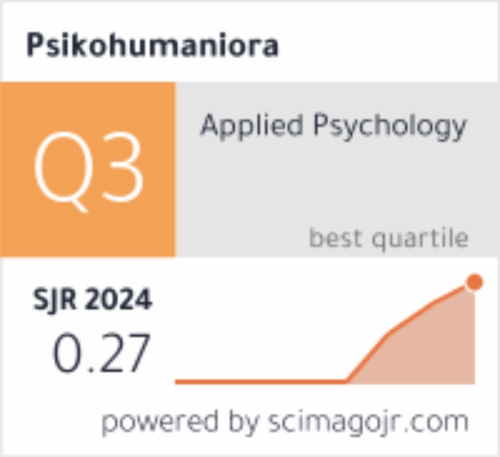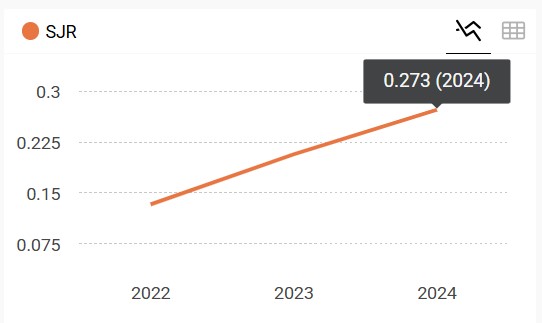The perception of attachment effect in parents and peers on aggressive behavior in male adolescents
DOI:
https://doi.org/10.21580/pjpp.v4i1.3118Keywords:
perception of attachment, aggressive behavior, adolescentAbstract
Interaction among children with their parents and peers has an important role in developing aggression in adolescents. Negative interaction can form children’s negative perception of attachment to their parents and peers. In turn, it facilitates adolescent’s negative schemes from childhood to adolescence. Negative scheme children are generally easy to get anxious, difficult to trust another person in interaction, and aggressive. This study aimed to examine the perceptions of attachment effect to their father, mother, and peer on male adolescents' aggressive behaviors. The subjects of this study were 31 adolescents aged 12-15 years old, who lived in PSMP Antasena in Magelang. They were selected through purposive sampling technique. The data were collected using aggressive behavior scale and modification of parents and peer attachment inventory. The method used for analyzing data was multiple regression. The results of the analysis showed that R=0.688, p<0.01, indicating that the perceptions of father, mother and peer attachment significantly can predict aggression in male adolescents.Downloads
References
Abrori, F. (2016). Rehabilitasi anak nakal ala Panti Antasena. Retrieved from https://www.liputan6.com/regional/read/2691456/rehabilitasi-anak-nakal-ala-panti-antasena
Allen, J. P., McElhaney, K. B., Land, D. J., Kuperminc, G. P., Moore, C. W., O’Beirne-Kelly, H., & Kilmer, S. L. (2003). A secure base in adolescence: Markers of attachment security in the mother-adolescent relationship. Child Development, 1(74), 292–307. https://doi.org/10.1111/1467-8624.t01-1-00536
Allen, J. P., Moore, C., Kuperminc, G., & Bell, K. (1998). Attachment and adolescent psychosocial functioning. Child Development, 5(69), 1406–1419. https://doi.org/10.1111/j.1467-8624.1998.tb06220.x
Allen, S., & Daly, K. (2007). The effects of father involvement: An updated research summary of the evidence inventory. Work. Guelph: Centre for Families, Work & Well-Being, University of Guelph.
Anderson, C. A., & Bushman, B. J. (2002). Human aggression. Annual Review of Psychology, 53, 27–51. https://doi.org/10.1146/annurev.psych.53.100901.135231
Bowlby, J. (1969). Attachment and loss: Volume 1. Attachment. New York: Basic Books. https://doi.org/10.1177/000306518403200125
Bukhori, B. (2005). Dzikir dan agresivitas santri. Jurnal Psikologi Islami, 1(2), 141–151.
Bukhori, B. (2008). Zikir al-asma’al-husna solusi atas problem agresivitas remaja. Semarang: Rasail Media.
Check, J. V. P., Perlman, D., & Malamuth, N. M. (1985). Loneuness and aggressive behaviour. Journal of Social and Personal Relationships, 2(3), 243–252. https://doi.org/10.1177/0265407585023001
Colin, V. L. (1996). Human attachment. United State of America: McGraw-Hill.
Collins, N. L., & Read, S. J. (1990). Adult Attachment, Working Models, and Relationship Quality in Dating Couples. Journal of Personality and Social Psychology, 58(4), 644–663. https://doi.org/10.1037/0022-3514.58.4.644
Collins, W. A., & Laursen, B. (2004). Changing relationships, changing youth: Interpersonal contexts of adolescent development. Journal of Early Adolescence, 24(1), 55–62. https://doi.org/10.1177/0272431603260882
Crick, N. R., & Dodge, K. A. (1996). Social information-processing mechanisms in reactive and proactive aggression. Child Development, 67(3), 993–1002. https://doi.org/10.1111/j.1467-8624.1996.tb01778.x
Desmita. (2012). Psikologi perkembangan. Bandung: Remaja Rosdakarya.
Dodge, K. A., Coie, J. D., & Lynam, D. (2007). Aggression and antisocial behavior in girls. In W. Damon & R. M. Lerner (Eds.), Handbook of child psychology (Sixth Edit, pp. 719–788). United States of America: John Wiley & Sons, Inc. https://doi.org/1002/9780470147658.chpsy0312
Eliani, J., Yuniardi, M. S., & Masturah, A. N. (2018). Fanatisme dan perilaku agresif verbal di media sosial pada penggemar idola K-Pop. Psikohumaniora: Jurnal Penelitian Psikologi, 3(1), 59–72. https://doi.org/10.21580/pjpp.v3i1.2442
Gay C. Armsden, M. T. G. (1987). The inventory of parent and peer attachment: Individual differences and their relationship to psychological well-being in adolescence. Journal of Youth and Adolescence, 16(5), 427–454. https://doi.org/10.1007/BF02202939
Guarnieri, S., Ponti, L., & Franca, T. (2010). The inventory of parent and peer attachment (IPPA): A study on the validity of styles of adolescent attachment to parents and peers in an Italian sample. TPM - Testing, Psychometrics, Methodology in Applied Psychology, 17(3), 103–130. https://doi.org/10.1449/30135
Gullone, E., & Robinson, K. (2005). The Inventory of Parent and Peer Attachment - Revised (IPPA-R) for children: A psychometric investigation. Clinical Psychology and Psychotherapy, 12(1), 67–79. https://doi.org/10.1002/cpp.433
Helmi, A. F. (1999). Gaya kelekatan dan konsep diri. Jurnal Psikologi, (1), 9–17. https://doi.org/10.22146/jpsi.6995
Laible, D. J., Carlo, G., & Raffaelli, M. (2000). The differential relations of parent and peer attachment to adolescent adjustment. Journal of Youth and Adolescence, 29(1), 45–59. https://doi.org/10.1023/A:1005169004882
Laumi, & Adiyanti, M. G. (2012). Attachment of late adolescent to mother, father, and peer, with family structure as moderating variable and their relationship with self-esteem. Jurnal Psikologi, 39(2), 129–142. https://doi.org/10.22146/jpsi.6981
Lestari, S. (2012). Psikologi keluarga. Jakarta: Kencana Prenada Media Group.
Loeber, R., & Hay, D. (2002). Key issues in the development of aggression and violence from childhood to early adulthood. Annual Review of Psychology, 48, 371–410. https://doi.org/
1146/annurev.psych.48.1.371
Long, E. C. J., Fish, J. N., Scheffler, A., & Hanert, B. (2014). Memorable experiences between fathers and sons: Stories that shape a son’s identity and perspective of his father. The Journal of Men’s Studies, 22(2), 122–139. https://doi.org/10.3149/jms.2202.122
Mortazavi, Z., Sohrabi, F., & Hatami, H. R. (2012). Comparison of attachment styles and emotional maturity between opiate addicts and non-addicts. Annals of Biological Research, 3(1), 409–414.
Nelis, S. M., & Rae, G. (2009). Brief report: Peer attachment in adolescents. Journal of Adolescence, 32(2), 443–447. https://doi.org/10.1016/j.adolescence.2008.03.006
Nickerson, A. B., & Nagle, R. J. (2005). Parent and peer attachment in late childhood and early adolescence. Journal of Early Adolescence, 25(2), 223–249. https://doi.org/10.1177/0272431604274174
Nikiforou, M., Georgiou, S. N., & Stavrinides, P. (2013). Attachment to parents and peers as a parameter of bullying and victimization. Journal of Criminology. https://doi.org/10.1155/2013/484871
Papalia, D. E., Olds, S. W., & Feldman, R. D. (2009). Human development (11st ed.). Boston: McGraw-Hill.
Rolls, E. T., Hornak, J., Wade, D., & McGrath, J. (1994). Emotion-related learning in patients with social and emotional changes associated with frontal lobe damage. Journal of Neurology, Neurosurgery and Psychiatry, 57(2), 1518–1524. https://doi.org/10.1136/jnnp.57.12.1518
Sarwono, S. W. (2012). Psikologi Remaja. Jakarta: PT. Raja Grafindo Persada.
Setyawan, D. (2015). KPAI: Pelaku Kekerasan Terhadap Anak Tiap Tahun Meningkat. Retrieved from http://www.kpai.go.id/
Shaffer, D. R. (2009). Social and Personality Development (6th ed.). Australia: Wadsworth/Cengage Learning.
Shaheen, F., & Jahan, M. (2014). Role of self esteem in development of aggressive behaviour among Adolescents. International Journal of Education and Psychological Research, 3(4), 54–57.
Simons, K. J., Paternite, C. E., & Shore, C. (2001). Quality of parent/adolescent attachment and aggression in young adolescents. Journal of Early Adolescence, 21(2), 182–203. https://doi.org/10.1177/0272431601021002003
Slater, M. D., Henry, K. L., Swaim, R. C., & Anderson, L. L. (2003). Violent media content and aggressiveness in adolescents: A downward spiral model. Communication Research, 30(6), 713–736. https://doi.org/10.1177/0093650203258281
Talebi, B. Z., & Verma, P. (2007). Aggression and attcachment security. Iranian Journal of Psychiatry, 2(2), 72–77.
Tim Liputan Kemenpppa. (2016). Perkuat ketahanan keluarga demi mengurangi kekerasan terhadap anak. Retrieved from https://www.kemenpppa.go.id/index.php/page/read/30/497/perkuat-ketahanan-keluarga-demi-mengurangi-kekerasan-terhadap-anak
Trentacosta, C. J., & Fine, S. E. (2010). Emotion knowledge, social competence, and behavior problems in childhood and adolescence: A meta-analytic review. Social Development, 19(1), 1–29. https://doi.org/10.1111/j.1467-9507.2009.00543.x
Ul-Morshed, M., Nirobe, M. N. N., & Naz, H. (2015). A atudy of parental acceptance - Rejection and aggression towards parents of adolescence. Universal Journal of Psychology, 3(3), 132–135. https://doi.org/10.13189/ujp.2015.030405
Undang-Undang Republik Indonesia. Rencana pembangunan jangka panjang nasional tahun 2005-2025, Pub. L. No. 17 (2007). Indonesia.
Valois, R. F., MacDonald, J. M., Bretous, L., Fischer, M. A., & Drane, J. W. (2002). Risk factors and behaviors associated with adolescent violence and aggression. American Journal of Health Behavior, 26(6), 454–464. https://doi.org/10.5993/AJHB.26.6.6
Wright, M., Aoyama, I., Kamble, S., Li, Z., Soudi, S., Lei, L., & Shu, C. (2015). Peer Attachment and Cyber Aggression Involvement among Chinese, Indian, and Japanese Adolescents. Societies, 5(5), 339–353. https://doi.org/10.3390/soc5020339
Yamin, F. (2016). Berkelahi, seorang pelajar SMP dibacok temannya sendiri. Retrieved from https://regional.kompas.com/read/2016/09/08/22110081/berkelahi.seorang.pelajar.smp.dibacok.temannya.sendiri
Yusuf, S. (2010). Psikologi perkembangan anak dan remaja. Bandung: Remaja Rosdakarya.
Downloads
Published
How to Cite
Issue
Section
License
The copyright of the accepted article shall be assigned to the publisher of the journal. The intended copyright includes the right to publish the article in various forms (including reprints). The journal maintains the publishing rights to published articles.
In line with the license, authors and any users (readers and other researchers) are allowed to share and adapt the material only for non-commercial purposes. In addition, the material must be given appropriate credit, provided with a link to the license, and indicated if changes were made. If authors remix, transform, or build upon the material, authors must distribute their contributions under the same license as the original.



